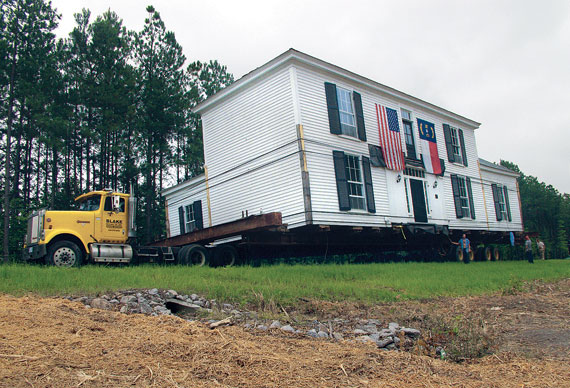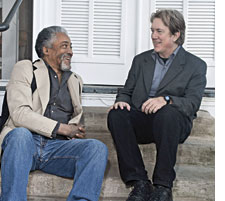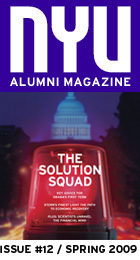documentary
A House Reunited
A new film follows the move of a Southern plantation—and reckons with its complicated past
by Kathryn Robertson / CAS ’09
In 2004, historian Robert Hinton received a nervous voicemail from one Godfrey Cheshire, a filmmaker and critic based in New York City. In a lilting North Carolinian accent, Cheshire, who is white, explained that he had seen Hinton’s recent letter to the editor in The New York Times Book Review, in which he talked about growing up black in Raleigh. He was working on a project related to a plantation near there called Midway. Could they talk?
To escape suburban sprawl, Midway plantation was trucked to quieter pastures.
Hinton knew Midway Plantation; he’d long suspected his grandfather had been born a slave there around 1860 and been given the surname of its owners, the Hintons. Intrigued, he invited Cheshire to his office in NYU’s Africana Studies department, and quickly realized that he was sitting before the descendant of his grandfather’s former owner. He wanted to dislike him but instead found himself gladly pulled into Cheshire’s new film about the relocation of the 160-year-old plantation house. Cheshire’s cousin, the current owner, had decided that the best way to preserve the home, which was now lapped by a new highway and suburban subdivisions, was to hoist the 280-ton building onto wheels and slowly roll it to a new, nearby resting place. Cheshire knew that he could not tell the home’s full story without discussing slavery. He needed Hinton’s help, both as a scholar and as someone intimately connected to Midway.
The resulting documentary, Moving Midway, presents a region full of complexity, emotion, and quirk as it follows the home’s physical move and contemplates the mythology surrounding these icons of the Old South and the living legacy of slavery. (During the project, filmmakers discovered another branch of black Hintons who, because of a liaison between an owner and a plantation cook, are not only descendents of Midway’s former slaves but also blood relations of Cheshire and his kin.) On balance too is the South’s hunger for both modernization, in the form of strip malls and interstates, and its antebellum past. The New York Times’ A.O. Scott wrote that the film “takes up the agonies and ironies of Southern history with remarkable empathy, wit, and learning,” and New York magazine named it runner-up for best documentary film of 2008.

Historian Robert Hinton (Left) and Filmmaker Godfrey Cheshire consider the Move's Meaning.
Central to the film is the tension between the perspectives of Cheshire, the writer, director, and co-producer, and Hinton, chief historian and associate producer. For Cheshire, and many of his relatives, the film was an opportunity to indulge in nostalgia, to revel in seven generations of family lore about ghosts and outsize characters. Though the house was built in 1848, it stood on land granted to the family by the English crown in 1739. “As a kid, it was fun for me to go out there on the weekends,” he remembers. “The place had an old and magical feeling.”
The project linked Hinton with a past not so easily retraced. “I was walking on floors that my great grandmother had swept,” he explains. “I slept in a bed she had probably made a thousand times, and I ate at a table where she had served the white folks, and so, while it wasn’t an ideal situation, it felt like I was reconnecting.”
The big house, the land once filled with tobacco fields, and the graveyard where Hinton's relatives were buried were testaments to what they endured. “My people built the house, and I wanted it to be preserved as proof of their labor and their skill,” he says. “As long as it exists, no one can say that they weren’t enslaved.”
In a final scene, Cheshire’s cousin hosts an uncommon and unlikely family reunion at Midway, now located three miles north of the original site on a spread of 46 acres. “I would like to think there’ll be further contacts between the two branches of the family and maybe even some shared reunions in the future,” Cheshire says. “I feel a strong kinship, literally, through our shared interest in family history.” Both he and Hinton consider the film just the first words of a longer, more difficult conversation, which they plan to continue, perhaps in a book, about Midway and the reconciliation between the family’s black and white branches. “I want to encourage people—black and white—to talk about slavery,” Hinton says. “Because neither want to, and we can’t make sense out of racism unless we talk about slavery.”
bottom photo © Conrad Richard Jordan







